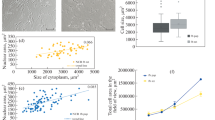Summary
The human dermis consists of two morphologically different layers. A loose meshwork of thin collagenous fibres is characteristic for the adventitial dermis with includes the papillary and the periadnexal dermis. Thick, coarse collagen bundles are the main feature of the reticular dermis. Two different collagens, type I and type III occur in the dermis as shown previously by biochemical analyses. Antibodies specific for type I collagen or type III collagen and their corresponding precursors were used in indirect immunofluorescence tests to localize the various collagens in frozen sections of normal adult skin. Whereas type I collagen is found in all dermal layers, the main part of type III collagen can be found within the adventitial dermis. Antibodies against the precursor of type I collagen stain only a bandlike region immediately beneath the epidermis. Antibodies against the precursor of type III collagen stain the same regions as antibodies against the helical part of type III collagen.
Zusammenfassung
An der menschlichen Dermis lassen sich morphologisch zwei verschiedene Schichten unterscheiden. Ein lockeres Maschenwerk aus dünnen kollagenen Fasern ist charakteristisch für die adventitielle Dermis, welche die papilläre und die periadnexielle Dermis einschließt. Dicke, plumpe Kollagenfaserbündel sind das Hauptmerkmal der retikulären Dermis. Biochemisch können die beiden Kollagentypen I und III in der menschlichen Dermis nachgewiesen werden. Typspezifische Antikörper gegen Typ I Kollagen, Typ III Kollagen und die entsprechenden Prokollagene erlauben in der indirekten Immunofluorescenztechnik an Gefrierschnitten von normaler Erwachsenenhaut eine Lokalisation der genetisch differenten Kollagene. Typ I Kollagen wird in allen Schichten gefunden, Typ III Kollagen ist mit seinem Hauptanteil auf die adventitielle Dermis beschränkt. Antikörper gegen Prokollagen Typ I färben nur eine schmale bandförmige Zone unmittelbar unterhalb der Epidermis. Antikörper gegen Prokollagen Typ III reagieren innerhalb derselben Bereiche der Dermis wie Antikörper gegen den helikalen Anteil von Typ III Kollagen.
Similar content being viewed by others
References
Chung, E., Miller, E. J.: Collagen polymorphism: Characterization of molecules with the chain composition [α1(III)]3 in human tissues. Science183, 1200–1201 (1974)
Epstein, E. H.: [α1(III)]3 Human skin collagen. Release by pepsin digestion and preponderance in fetal life. J. Biol. Chem.249, 3225–3231 (1974)
von Figura, K.: Biochemie und Funktion der Glykosaminoglykane der Haut. Hautarzt27, 206–213 (1976)
Fujii, R., Kühn, K.: Isolation and characterization of pepsin-treated type III collagen from calf skin. Hoppe-Seyler's Z. Physiol. Chem.356, 1793–1801 (1975)
Furthmayr, H., Timpl, R., Stark, M., Lapière, Ch. M., Kühn, K.: Chemical properties of the peptide extension of the pα 1 chain of dermatosparactic skin procollagen. FEBS Letters28, 247–249 (1972)
Gay, St., Müller, P. K., Meigel, W. N., Kühn, K.: Polymorphie des Kollagens. Neue Aspekte für Struktur und Funktion des Bindegewebes. Hautarzt27, 196–205 (1976a)
Gay, St., Meigel, W. N.: Immunohistochemical identification of collagen types in skin diseases. J. invest. Derm.66, 262 (1967b) abstr.
Hahn, E., Timpl, R.: Involvement of more than a single polypeptide chain in the helical antigenic determinants of collagen. Europ. J. Immunol.3, 442–446 (1973)
von der Mark, K., von der Mark, H., Gay, St.: Study of differential collagen synthesis during development of the chick embryo by immunofluorescence. II. Localization of type I and type II collagen during long bone development. Develop. Biol.53, 153–170 (1976)
Miller, E. J.: Biochemical characteristics and biological significance of the genetically distinct collagens. Molec. Cell. Biochem.13, 165–195 (1976)
Nowack, H., Gay, St., Wick, G., Becker, U., Timpl, R.: Preparation and use in immunohistology of antibodies specific for type I and type III collagen and procollagen. J. Immunol. Meth.12, 117–124 (1976)
Reed, R. J., Elmer, L. C.: Multiple acral fibrokeratomas (a variant of prurigo nodularis). Arch. Derm.103, 286–297 (1971)
Reed, R. J., Clark, W. H., Mihm, M. C.: The cutaneous collagenoses. Hum. Pathol.4, 165–186 (1973a)
Reed, R. J., Ackermann, A. B.: Pathology of the adventitial dermis. Anatomic observations and biologic speculations. Hum. Pathol.4, 207–217 (1973b)
Rhode, H., Becker, U., Nowack, H., Timpl, R.: Antigenic structure of the aminoterminal region in type I procollagen. Characterization of sequential and conformational determinants. Immunochem.13, 967–974 (1976)
Timpl, R., Wick, G., Furthmayr, H., Lapière, Ch. M., Kühn, K.: Immunochemical properties of procollagen from dermatosparactic calves. Europ. J. Biochem.32, 584–591 (1973)
Timpl, R., Glanville, R. W., Nowack, H., Wiedemann, H., Fietzek, P. P., Kühn, K.: Isolation, chemical and electron microscopical characterization of neutral-salt-soluble type III collagen and procollagen from fetal bovine skin. Hoppe-Seyler's Z. Physiol. Chem.356, 1783–1792 (1975)
Timpl, R.: Immunological studies on collagen in Biochemistry of collagen, pp. 319–375. Ramachandran, G. N., Reddi, A. H. (eds.). New York: Plenum Publ. Corp. 1976
Weber, L., Meigel, W. N.: Relation of type I and type III collagen in normal skin and scar tissue. J. invest. Derm.66, 260 (1976) abstr.
Weber, L., Meigel, W. N., Rauterberg, J.: SDS-Polyacrylamide gel electrophoretic determination of type I and type III collagen in small skin samples. Arch. Derm. Res. 1977 (in press)
Wick, G., Furthmayr, H., Timpl, R.: Purified antibodies to collagen: An immunofluorescence study of their reaction with tissue collagen. Int. Arch. Allerg. appl. Immun.48, 664–679 (1975)
Wick, G., Nowack, H., Hahn, E., Timpl, R., Miller, E. J.: Visualization of type I and II collagens in tissue sections by immunohistologic techniques. J. Immunol.117, 298–303 (1976a)
Wick, G., Kraft, D., Kokoschka, E. M., Timpl, R.: The diagnosic application of specific anti-procollagen sera. I. Analysis of skin biopsies. Clin. Immunol. Immunpath.6, 182–191 (1976b)
Author information
Authors and Affiliations
Rights and permissions
About this article
Cite this article
Meigel, W.N., Gay, S. & Weber, L. Dermal architecture and collagen type distribution. Arch. Derm. Res. 259, 1–10 (1977). https://doi.org/10.1007/BF00562732
Received:
Issue Date:
DOI: https://doi.org/10.1007/BF00562732




